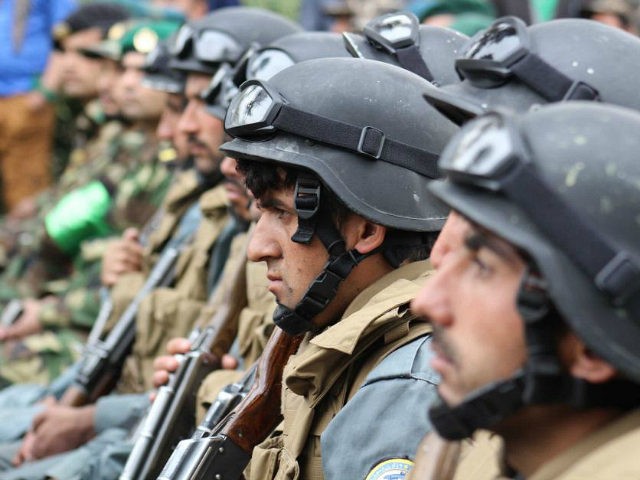It is hard to argue that the U.S.-backed Afghan National Defense and Security Forces (ANDSF) lack the will to defend their country when they have incurred a historic number of fatalities in the past year, primarily at the hands of a resurgent Taliban, the most potent jihadist group in Afghanistan.
The ANDSF does continue to suffer from capability lapses despite ongoing U.S. support in the form of military assistance and training as well as billions in taxpayer funds devoted to its development since around the time the war started in October 2001.
In its most recent report to Congress, the Special Inspector General for Afghanistan Reconstruction (SIGAR), a U.S. watchdog agency, notes:
Fighting insurgents and mentoring, and supporting Afghan security forces since 2002 has cost more than 2,400 American military members their lives, and has left more than 20,000 wounded. Additional thousands of Coalition personnel and contractors have also died during the conflict. Afghan losses have been the greatest of all: more than twice as many ANDSF members were killed in the single year of 2016 than U.S. forces in Afghanistan have lost since 2001.
The ANDSF includes police and army units. Although the Taliban is primarily responsible for U.S. and Afghan deaths, including civilians, the group is not officially identified as a terrorist organization by the United States.
The Taliban became the world’s most prolific terrorist group within a year after former President Barack Obama declared an end to the U.S. command mission, transferring security responsibilities to Afghan forces when they were facing capability deficiencies.
SIGAR reports:
Afghanistan remains in the grip of a deadly war. Casualties suffered by the Afghan National Defense and Security Forces (ANDSF) in the fight against the Taliban and other insurgents continue to be shockingly high: 807 were killed in the first six weeks of this year. Likewise, civilian casualties in 2016 were the highest since the United Nations Assistance Mission in Afghanistan began reporting them in 2009.
The vast majority of U.S. and Afghan security and civilian fatalities occurred under Obama’s watch.
Besides Afghan deaths, security incidents in the war-devastated country, primarily fueled by clashes with the Taliban, have also reached record levels — the highest number since the United Nations began keeping track in 2007.
The security incidents continue to primarily occur along Afghanistan’s border with Pakistan, which has been accused by Afghan and U.S. officials of providing sanctuary to the Taliban, its ally al-Qaeda, and their affiliate the Haqqani Network, among other terrorist groups.
Citing a March 2017 assessment by the U.N., SIGAR chief John Sopko writes in the report to Congress, “Afghanistan’s security situation has worsened over the last quarter, with intensifying armed clashes between the Afghan security forces and the Taliban, and with notable high-profile attacks by insurgent and extremist groups,” later adding:
Security incidents throughout 2016 and continuing into the first quarter of 2017 reached their highest level since UN reporting began in 2007. Armed clashes between the security forces and the Taliban comprised 63% of all security incidents in Afghanistan during that period and marked a 22% increase from the same period in 2015–2016.
During the last year, half of all recorded security incidents continued to occur in the southern, southeastern, and eastern regions [along the Afghanistan-Pakistan border], according to the UN.
The SIGAR report primarily covers the first quarter of the Trump administration — January 1 thru March 31.
SIGAR acknowledged that the Afghan security forces are still facing capability lapses despite substantial U.S. military and monetary support.
Inspector General (IG) Sopko notes:
More than $71 billion of U.S. appropriations for Afghanistan reconstruction since 2002—about 61% of the total—have gone toward training, clothing, housing, equipping, moving, and sustaining the 300,000-plus members of the Afghan National Defense and Security Forces, the ANDSF. The growing numbers and fighting capability of the ANDSF have permitted the United States to reduce its own military presence in Afghanistan by 90% over the past five years, to fewer than 9,000 personnel.
However, it adds:
The ANDSF faces many problems: unsustainable casualties, temporary losses of provincial and district centers, weakness in logistics and other functions, illiteracy in the ranks, often corrupt or ineffective leadership, and over-reliance on highly trained special forces for routine missions.
In addition, about 35% of the force does not reenlist each year, so even full recruitment to cover attrition might dilute its quality.
Furthermore, corrupt Afghan officials are using American taxpayer funds to pay for security troops that do not exist, known as “ghost soldiers.”
IG Sopko reports:
In January 2017, U.S. media outlets reported that 30,000 ghost personnel have been identified within the ANA [Afghan National Army]. As a result, U.S. officials confirmed that as of January 1, 2017, ANDSF salaries will be paid only to those MOD [Ministry of Defense] and MOI [Ministry of Interior] personnel who are correctly registered in AHRIMS [Afghan Human Resources Information Management System].
SIGAR learned from the U.S. military in Afghanistan that the government controls or influences an estimated 60 percent of the country, insurgents (primarily the Taliban) about 11 percent, and the remaining 29 percent is considered “contested.” That means the government may have lost control or influence of about 40 percent of Afghanistan.

COMMENTS
Please let us know if you're having issues with commenting.